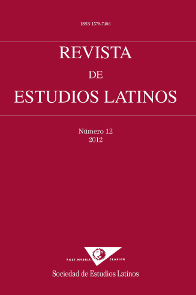La alusión aprina de singularis en las Verrinas
DOI:
https://doi.org/10.23808/rel.v12i0.87787Palabras clave:
ambigüedad; polisemia; homonimia; sentido alusivo; ironía ciceroniana.Resumen
El sentido alusivo, por su carácter secundario, tiene una consistencia menor; por ello, será inútil exigirle la claridad del sentido obvio. ¿Sugiere el adjetivo singularis, frecuentemente aplicado a Verres y a Apronio, dos personajes con nombre de «verraco» y de «jabalí», una alusión aprina o no?. Esa es la cuestión que debatimos aquí.
Frente al insulto directo (uerrem tam nequam) que el orador pone en boca de la gente, él prefiere la alusión de baja intensidad (singularis nequitia). La afirmación de tal sentido alusivo supone anticipar más de cuatro siglos y medio, desde la Vulgata a Cicerón, la referencia al cerdo salvaje del adjetivo que constituirá el nombre del jabalí en la mayor parte de las lenguas románicas.
Descargas
Citas
Battisti, Carlo & Giovanni Alessio, 1975: Dizionario etimologico italiano, I-V, Florencia, G. Barbèra.
Coseriu, Eugenio, 2007: Lingüística del texto. Introducción a la hermenéutica del sentido. Edición de Ó. Loureda, Madrid, Arco/Libros.
DRAE 22 2001: Diccionario de la lengua española, Madrid, Real Academia Española.
Du Cange, (1954): Glossarium Mediae et Infimae Latinitatis, VI Bd., Graz, Akademische Druck- und Verlagsanstalt.
García-Hernández, B., 2007: De iure uerrino. El derecho, el aderezo culinario y el augurio de los nombres, Madrid, Dykinson.
—, 2012a: «El sentido alusivo de singularis en el discurso ciceroniano Pro Sulla», Homenaje a Jordi Pérez Durà: Studia Philologica Valentina 14 (n. s. 11), 69-87.
—, 2012b: «Innovaciones latinas y románicas en el campo léxico de su¯s (‹cerdo›)», E. Casanova Herrero & C. Calvo Rigual (eds.), Actes del 26é Congrés Internacional de Lingüística i Filologia Romàniques, vol. IV, Berlín, Walter de Gruyter, 529-536.
Gildenhard, Ingo, 2011: Cicero, Against Verres, 2.1.53-86, Cambridge, Open Book Publishers.
Menéndez Pidal, Ramón, 1900: «Etimologías españolas», Romania 29, 334-379.
Merguet, H. (1877-84): Lexikon zu den Reden des Cicero mit Angabe sämmtlicher Stellen, I-IV, Jena, G. Fischer.
Petrone, Gianna, 2009: «Nomen/omen. Poetica e funzione dei nomi nelle commedie di Plauto», id., Quando le muse parlavano latino. Studi su Plauto. Bolonia, Pàtron Editore.
Poccetti, Paolo, 2009: «Un animal au centre du monde. Le cochon dans l’antiquité italique et romaine», Schedae 8-1, 125-142.
Uría, Javier, 2010: Reseña de B. García-Hernández 2007, Tulliana (www.tulliana.eu), 1-4
Wartburg, Walther von, 1964: Französisches Etymologisches Wörterbuch. 11. Bd.,Basilea, Zbinden Druck und Verlag AG.
Descargas
Publicado
Cómo citar
Número
Sección
Licencia
Derechos de autor 2012 Revista de Estudios Latinos

Esta obra está bajo una licencia internacional Creative Commons Atribución-NoComercial-SinDerivadas 4.0.
Los originales publicados en las ediciones impresa y electrónica de esta revista son propiedad de las personas autoras de los mismos y se podrán difundir y transmitir siempre que se identifique la fuente original y la autoría en cualquier reproducción total o parcial de los mismos, y siempre que no tengan una finalidad comercial.






